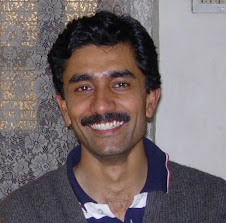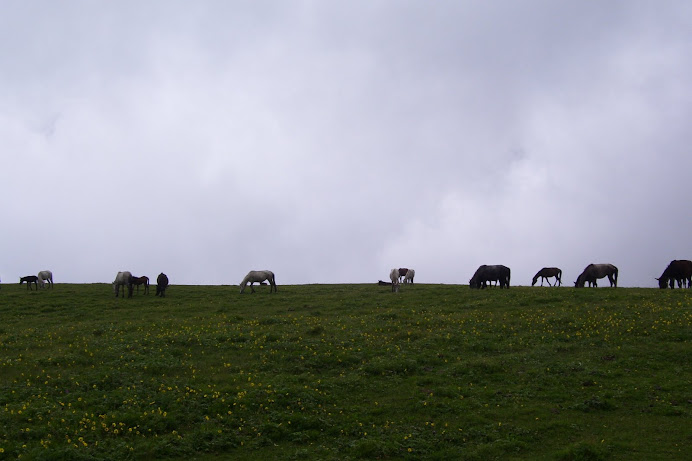It's got everything going for it. Deep virgin forests, gurgling brooks, breath-taking campsites, miles of undulating meadows, snow and ice, and the taste of a great adventure as you climb from 8,000 ft to 17,000 ft in 4 days.
Your trek starts at Lohajung (8,600 ft), a tiny pass, that slips in through the Gwaldam face of the mountain and into the Wan valley.
Lohajung is the last stop for replenishing supplies. It is not a supermarket, but you get your usual potatoes, onions, and everyday vegetables. Even film rolls. Stock yourself well and book yourself a room at the GMVN rest house or the FRH (Forest Rest House). K S Danu, the caretaker is helpful and will arrange guide, porters and mules for the trek as well.
Getting porters isn't difficult and they are usually hovering around the bus stop. If you want a helpful guide who looks after you well, ask specifically for Narendra. All contact numbers are alongside.
Taking mules for the trek makes more sense than taking porters. Mules eat grass (plenty available on the trek) and not food (so saves you food costs on porters). Mules carry more load than porters and finally, they don't give you any trouble. The flip side: mules cost Rs 350 per day. Porters Rs 225. Guide: Rs 450 (updated rates as on September 2010). Check to see that you negotiate on a per day basis and not on 'padav' basis. 'Padav' rate is on per camp and not on per day. So if you advance two camps in one day, you'll pay for two camps.
Roopkund trek: GMVN guest house, Loharjung. It will cost you about Rs 150 per person per day (approximately), less if your group is larger.

Roopkund trek: Patwal Tourist Lodge, Loharjung. It will cost you Rs 250 per room (twin sharing). A cleaner and brighter place to stay in Loharjung.

Roopkund: Day 1. Loharjung to Didna (4½ hrs. Level: Easy initially, moderate climb at the end).
From Loharjung, just behind the bus stand is a trail that takes you to Raun Bagad, an iron bridge, just below Didana village. This is a well marked descending trail through mixed forests.
Alternative, follow the road that leads to Wan. It's a 6 km easy walk to Kulling village and then descend to Raung Bagad.
Whatever route you take, it is a good way to flex your hamstrings before you start your climb to Didana Village.
All along your walk to Raun Bagad/Kulling you hear the whistles of the thrushes, the soft chirps of the swallows amongst the Rhododendrons. Below, the Wan river tumbles about as it rushes to meet the Bedni Ganga and seemingly out of the depths of the river, you'll spot Lammergeiers, their massive wings stretched out catching the eddies.

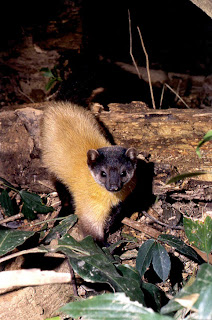
It is not uncommon to spot the yellow throated marten on this section. Martens have a yellow and black head and back, a deep canary yellow throat, and a bushy black tail. Though it is a bit clumsy on the ground, it climbs trees very well. We spotted one crossing and recrossing our path for a while. The locals don't like them and shoo them away with a pellet of stones. Martens are good stealers and often grab a hen from the villages.
If you have taken the route on the road, Kulling village springs out on you at a bend (6 kms from Loharjung, 8,200 ft). A cluster of white set against the emerald green of stepped hills. Kulling is a cluster of not more than 20 houses. Count them in the picture below. This is the entire Kulling village.
Roopkund trek: Kulling Village. Catch the trail that leads out from the bottom of the village like a tail. That's the trail you have to take. Click on image for a larger view.

From the Kulling village, it is quite a descent to the Wan river. You drop height and you don't like it, knowing in a while you'll have to climb all the height lost on the other bank.
If you have taken the trail through the mixed forest, then it is a gradual descent to the river and you don't feel it.
2 hours out of Loharjung, you reach an iron bridge over the river. This is Raun Bagad, a grassy bank on the river -- a good place to camp. Think about this if you reach Loharjung early and looking for a camp site that gives you a head start.
The trail starts to climb right after you cross the river. It is a zig-zag climb to Didna. The climb's moderate but your legs tire easily. You aren't used to it and your body's mechanism rebel. Breathing hard, you'll reach Didna in about an hour and half's time. Stretch it to two if you are out of condition.
Didana village can be a bit confusing with many trails running into it. Stick to the trails that go around the village on the outer peripheri -- they lead directly to the Didana camp site, a clearing 200 ft above the village.
Didna camp site is a grassy field just 10 minutes above the village. An ideal spot with a clear stream running down to its right. The campsite gazes across the valley. Loharjung, Kulling and Wan span left to right in a sweep. Behind you through the Oak forest, high above is your destination for tomorrow -- the twin meadows of Ali and Bedni Bugyal.
Roopkund trek: Didana Camp site

Roopkund Trek facts:
There are two ways to reach Ali Bugyal from Didna. If you are looking across the valley (like in the photograph), to your left is Tolpani a cluster of shepherd's hut 3 kms away and 1,000 ft higher. The trail to Tolpani moves away from the general direction of Ali Bugyal. At Tolpani it veers a sharp left, traverses across the mountain side, high above the Didna camp site and joins the trail to Ali.
An alternative route is to climb directly to Ali without going to Tolpani. My suggestion: If you reach Didna early, take a side excursion to Tolpani. It is a good climb through some of the densest oak you'll see. Under you is a never ending brown carpet of leaves. The climb to Tolpani is refreshing, helps you acclimatise and gets your limbs ready for the next day's tough climb to Ali Bugyal. Don't camp at Tolpani, but return to your Didna camp site. Didna to Tolpani and back can be done in 3 hours. Next day, climb directly to Ali Bugyal.
Day 2
Roopkund: Didna to Bedni Bugyal (via Ali Bugyal) (4½ - 5 hrs. Level moderate: Stiff climb at the beginning, easy walk at the end).
Start early from Didna. You want to get most of the climb behind you before the weather closes in sometime in the afternoon. You'll miss your best views of Ali bugyal with Trishul forming the backdrop if you get to Ali too late.
The trail's just to the right of the Didna camp site, hanging over the shoulder of Didna village. You cross the village and immediately afterwards the trail veers right and gets steep. Soon, you are amidst oaks and you can catch glimpses of Didna's rooftops below you. 10 mins later you come across a stream. Stop to catch your breath and fill in your water bottles. This is the last water point and there isn't any water source until Bedni, 4 hrs away. The water's cool and crisp and feeds the Didna village.
The climb through the dense oak forest is seductive. Sun beams light up the moss laden bark of the tress. A brown carpet of leaves marks the trail. The air is cool enough to make your sweat cold. Around you is a dense foliage of green, and as you climb the sweet smell of moist earth lingers around.


It is a 2,500 ft climb from Didna to Ali. Quite a bit if you are not used to climbing. Take it nice and slow and enjoy the views. It is perhaps one of the best that Himalays has to offer through dense oak forests.
The forest starts to thin after about 2½ hrs of climb (make it 3 if you are slow)Suddenly, abruptly, the oak falls behind you and stretched in front of you is a largest, greenest rolling carpet ever laid out for you. You've arrived at Ali Bugyal.
All tiredness forgotten, you soak in the mesmerising sight of the undulating meadows of Ali Bugyal. You are on the top of a ridge that spreads in every direction. Acres and acres of green meadow scooped out of the mountainside.
Clouds drift in from below, glide over the ridge and slide down the either side, all in a slow swift motion. You watch countless horses grazing on the bounty of nature. Foals tearing themselves across the turf in an uninhibited abandon, just being themselves.
The climb over, leisurely walk your way to Bedni Bugyal, 5 kms away and more or less at the same level. If you are tempted to take off your shoes and allow the feel of the carpet on your toes, just go ahead and do it!
Roopkund trek: My favourite picture. Just as I had composed the flowers on my viewfinder, the horse looked up and set up a perfect shot.

Towards the end of Ali Bugyal there's a short steep climb of 10 minutes before the trail leads you to Bedni Bugyal. The weather fluctuates in these parts and you can have moments of wild sunshine followed by anxious cloud cover. Keep your raincoat handy. Sometimes it rains for a few minutes leaving you frustrated, at times it could rain for a few hours.
A "L" in the folds of the mountain, and the Bedni Bugyal campsite unfolds below you, another heavenly strip of green overlooking the western valley. There's a tea house that serves up some much welcoming warm tea after your exhilarating climb to Bedni. You can get a bed here too, but chances are that some trekker would have already booked it. The GMVN rest house at Bedni can be booked in advance at Loharjung or online.
Roopkund trek: The Bedni Bugyal camp site (11,500 ft). If you want a perfect setting for camping in the Himalays, then Bedni would be among the top in your list.

Roopkund trek: Day 3
Bedni Bugyal to Bhagwabasa (4 - 4½ hrs. Level moderate: Easy assent at the beginning, gradual decent followed by a stiff climb in the middle. Easy walk at the end).
There's is a big change in the days trek. You start at the meadows, gradually climb out of them, make a steep dash to gain height and finally camp on the snow line. The day's trek will also see you climbing from 11,500 ft to 14,500 ft. For the first time on the trek you will feel the effects of altitude and thin air.
Start your day early again. You want to be in Bhagwabasa as early as possible to acclimatise yourself to the altitude before your final push to Roopkund. The trail to Bhagwabasa climbs out of the Bedni campsite in a gradual, easy meander. From your Bedni campsite you can follow it with your eye for 3 kms before it disappears into a saddle in the mountain.
It makes sense to break the day's trek into smaller stages. Stage one: Bedni Camp site to saddle on the mountain, where the trail crosses over. Stage two: Gradual decent to Patal Nachauni over the Ghora Lotani meadows. Stage three: Steep climb to Kalu Vinayak. Stage four: Gradual decending snow line walk to Bhagwabasa.
Stage one: There are two ways to catch the trail to Bhagwabasa. The easier option is to retrace your steps of yesterday to the point where you left the main trail to get into the Bedni campsite enclave (5-7 mins walk backwards). Get on the Roopkund trail and carry on your hike up and above the Bedni Camp site. Another option is to start from your camp site, skirt the Bedni Kund from the right, climb up the slope behind the Kund, and climb up to the trail from any direction you deem fit. This will save you half an hour to 45 mins of trekking time, but can leave you breathless.
Roopkund trek Bedni Bugyal to Bhagwabasa: In the picture below, the route marked in yellow is the regular trail. The one in green are the short cuts that you can take. Let the picture not fool you. It is quite a climb to reach the 'yellow' trail. Click on the picture for a bigger view.

Stage Two: When you cross the saddle, the trek exposes you to the other side of the ridge. The scenery is differently mesmerising. For the first time you also see remnants of the winter snow on the mountain flanks (on the other side). It is still meadow country and below you are the meadows of Ghora Lotani, the last stop for the horses. Beyond Ghora Lotani the meadows merge into the mountain side.
Ghora Lotani makes an excellent camp site. In fact an additional day spent at Ghora Lotani will help to acclimatise to the altitude, plus offer you great views. Not much has been written on Ghora Lotani but think of camping here either on your way to Roopkund or on your way back. It offers as good views as Bedni and has the added bonus of a strange sense of isolation. You can just about camp anywhere at Ghora Lotani, but ideally look to camp near the end of the meadows. A clear stream spews out of the side of slope and makes for a very good water source.
Roopkund trek: The Ghora Lotani camp site. Remarkable in its isolation. 12,500 ft
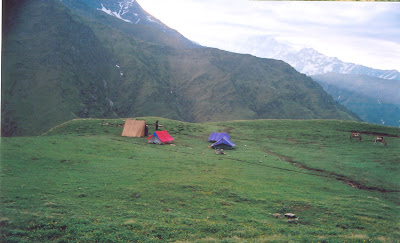
It takes about ½ hr to traverse over the Ghora Lotani meadows, before you reach the second saddle. Here, on your left you can see a trail that heads down to Bhuna (and further on to Sitel and Suthol). Upwards is your climb to Kalu Vinayak. The saddle signals the end of the meadows.
Take a break here, swig a bottle of water, tighten your straps and ready yourself for the climb to Kalu Vinayak
Roopkund trek: Patal Nachauni. The legends are more impressive than the location, but take a look before you start your climb to Kalu Vinayak.

The climb to Kalu Vinayak is a steep zig-zag up the mountain side and will take you to 14,500 ft. The distance isn't much, and the zig-zag trails makes you gain height very rapidly. Climb this section very slowly.
There really is no hurry and even if you are the slowest on the team you can reach Bhagwabasa in comfortable time. Take 10 minute breaks every 15 minutes. This is a cruicial height where most climbers feel the thinness in the air. You get breathless very soon and sometimes even feel dizzy. This would be ok, if you did not have to do the Roopkund climb the next day. Most folks climb this section like any other climb and find it difficult to acclimatise to the Roopkund altitude later on. Treat this section as the most crucial bit of your trek. In climbing time it takes around 1½ hrs to climb to Kalu Vinayak. Stretch it to 2½ hrs, even if you can climb quicker. By doing this, you'll find your body adjusting to the increased height and the lack of oxygen.
Climbing to Kalu Vinayak is a thrill and everytime you look up and take a bend on the trail, the ridge line gets closer, drawing you, inspiring you. Around you are the green, sheer mountainside. Below, you can follow the trail that you took from the first saddle over Ghora Lotani and finally to Kalu Vinayak.
Roopkund trek: Half way up to Kalu Vinayak, looking down over Ghora Lotani. You can follow the trail all the way from the first saddle to up where I am. From this height everything looks tiny.

Kalu Vinayak gets its name from the black Ganesh idol enclosed in a stone shrine just as you finish the climb from Ghora Lotani. Lots of temple bells and a large plate for you to make a donation. Everyone offers a prayer here for a safe pilgrimage to Roopkund. A donation of Rs 10/- is standard. Some offer biscuits instead! Choose!
Roopkund trek: The Kalu Vinayak Shrine. You touch snowline here.
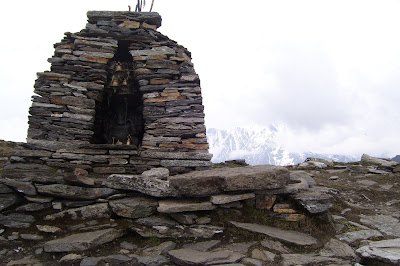
Beside the Kalu Vinayak shrine and right next to it you hit your first patch of snow. You are at the snow line.
The trail from Kalu Vinayak to Bhagwabasa is easy and gently sloping downwards. Bhagwabasa is 2 kms away and you can see the Bhagwabasa huts if you follow the trail with your eye. The trail meanders through snow patches.
Be careful on these snow patches. In June, by mid-day, they get soft and you can find yourself sinking to your knees in them. Step gingerly, quickly and skip your way across them. Better still, skirt around them.
Bhagwabasa is a cluster of stone huts put up by enterprising locals. The charge is on a bed basis. It could be Rs 150 to Rs 200 per bed depending on the season. On lean seasons the rates could go down to Rs 50. If you are staying at Bhagwabasa the locals will also cook for you at an additional cost. Carry your own sleeping bag -- the nights are extremely cold.
If you are carrying tents, then don't pitch camp at Bhagwabasa. Move ahead for another 5 minutes and you get a camp site on your left. This is Hunia Thal, a small clearing. There's space enough for 4 tents and no more. The place is rocky, but you don't have much of an option.
Roopkund trek: The Hunia Thal campsite. Just room enough for 4 tents. Note the rocky terrain. 14,500ft
At Bhagwabasa, night's turn extremely cold. Inside tent temperatures dip to 1°C. Outside I measured at -2°C at 2.30 in the night. These are mid summer temperatures. In September-October temperature will dip further to -5°C or -6°C. Bhagwabasa is windy too. In the wind chill the -2°C feels like -6°C. You need to put on all your warm clothings and then get inside your sleeping bag to brave the night.
Day 4
Roopkund trek: Bhagwabasa to Roopkund. Further up to Junargali. Return to Ghora Lotani via Bhagwabasa (2 - 2½ hrs to Roopkund. Level Moderate-Difficult.)
You need to start your push to Roopkund at 5.00 am. The sooner the better. Most trekkers cannot make it to Roopkund because they start late. The snow becomes soft and your feet start sinking in. You need to climb up to Roopkund while the snow is still hard. There's plenty of snow even in the middle of summer.
From Bhagwabasa it is about 5 kms to Roopkund. The stretch isn't long, but the entire bit is on snow patches. At some parts the slope is steep but most parts are easily trekkable.
(A side note here: we were the first group to trek to Roopkund in the summer of 2007. All earlier groups had turned back because they could not negotiate the snow patches. It is not crtical, but carrying an ice-axe could make a big difference. It did to us, because we could cut steps ahead of us. The groups following us had it relatively easy -- they just followed our steps.)
Roopkund from Bhagwabasa. The route is marked out in yellow. Where the trail ends in a fold in the mountain is Roopkund. Trishul towers over in the background. Click on image for a bigger picture.
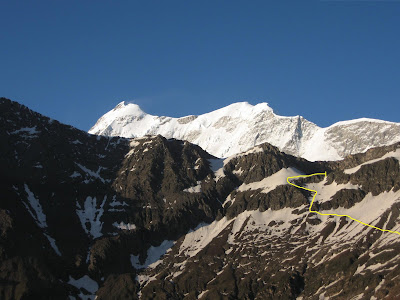
It takes about 2 hrs to climb up to Roopkund. Make it 2½ if you are slow. Ideally, if you have started at 5.00 am then you are going to get to Roopkund by 7.15. The climb is deliriously exhilarating. The last stretch of climbing over the rocky flank on the left, requires some clambering, but is over in 10 mins. The final bend on the snow shoulder will get your hearts pounding. Roopkund is right over the edge, two minutes away and yet you can't see it unless you get there.
Roopkund is like a crater on the side of the mountain face, a dip at the cusp of the mountain. It is much bigger than what most internet pictures suggest. All around are snowy flanks of the mountain. You have to actually climb down 50 ft to reach the edge of the lake. In late summer 2007, when we trekked, the entire lake was frozen and you could walk across from one end to another. And yes, there aren't any signs of any skeleton. Not a single one. Most of them are inside the lake (and no one in their right mind will venture to put in a toe in the frozen lake). The skeletons around the lake have disappeared as souviniers.

All over the internet, Roopkund is reported at 16,500 ft. GPS reading of a fellow trekker and our common sense suggest that Roopkund cannot be more than 15,500 ft. Whatever the altitude, you will feel the thiness of the air getting to you. Climbing a few steps take your breath away.
Getting to Roopkund is meaningless if you don't climb up to Junargali. From Roopkund, the sharp ridge line that towers above you is Junargali. After which it is a 3,000 ft drop to Shila Samudra. Junargali is about 500 ft higher than Roopkund, and it doesn't take much time to get there. The route is over snow that gently inclines upwards until it reaches the face of the mountain. After which it is a steep clamber on the mountain face to reach Junargali. The climb isn't for long, perhaps 200 ft. Gets over in perhaps 10-15 minutes. You just need to rest every few minutes, allowing your breath to get back.
Roopkund trek: Climbing up to Junargali. Roopkund is at the bottom of the picture and Junargali is the ridge line. Mt Nandagunti forms the background. Click on image for a bigger picture.


